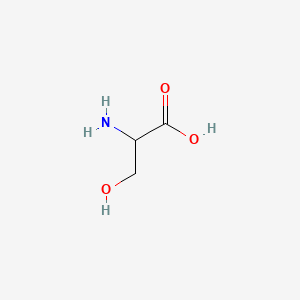| MeSH term | MeSH ID | Detail |
|---|---|---|
| Spinocerebellar Ataxias | D020754 | 4 associated lipids |
| Kidney Neoplasms | D007680 | 29 associated lipids |
| Body Weight | D001835 | 333 associated lipids |
Dl-serine
Dl-serine is a lipid of Fatty Acyls (FA) class. Dl-serine is associated with abnormalities such as Spastic syndrome, Machado-Joseph Disease, Huntington Disease, Infection and Gram positive septicemia. The involved functions are known as Lipid Binding, Proteolysis, Protein Processing, Post-Translational, Cytokinesis and Phosphorylation. Dl-serine often locates in Anatomic Site, Membrane, Cytoplasmic Domain, Extracellular and Blood. The associated genes with Dl-serine are polyserine, lipovitellin, Polypeptides, CSNK2A1 wt Allele and Spider Proteins. The related experimental models are Mouse Model.
Cross Reference
Introduction
To understand associated biological information of Dl-serine, we collected biological information of abnormalities, associated pathways, cellular/molecular locations, biological functions, related genes/proteins, lipids and common seen animal/experimental models with organized paragraphs from literatures.
What diseases are associated with Dl-serine?
Dl-serine is suspected in Huntington Disease, Infection, Spastic syndrome, Machado-Joseph Disease, Gram positive septicemia and other diseases in descending order of the highest number of associated sentences.
Related references are mostly published in these journals:
| Disease | Cross reference | Weighted score | Related literature |
|---|
Possible diseases from mapped MeSH terms on references
We collected disease MeSH terms mapped to the references associated with Dl-serine
PubChem Associated disorders and diseases
What pathways are associated with Dl-serine
There are no associated biomedical information in the current reference collection.
PubChem Biomolecular Interactions and Pathways
Link to PubChem Biomolecular Interactions and PathwaysWhat cellular locations are associated with Dl-serine?
Visualization in cellular structure
Associated locations are in red color. Not associated locations are in black.
Related references are published most in these journals:
| Location | Cross reference | Weighted score | Related literatures |
|---|
What functions are associated with Dl-serine?
Related references are published most in these journals:
| Function | Cross reference | Weighted score | Related literatures |
|---|
What lipids are associated with Dl-serine?
There are no associated biomedical information in the current reference collection.
What genes are associated with Dl-serine?
Related references are published most in these journals:
| Gene | Cross reference | Weighted score | Related literatures |
|---|
What common seen animal models are associated with Dl-serine?
Mouse Model
Mouse Model are used in the study 'Polyalanine and polyserine frameshift products in Huntington's disease.' (Davies JE and Rubinsztein DC, 2006).
Related references are published most in these journals:
| Model | Cross reference | Weighted score | Related literatures |
|---|
NCBI Entrez Crosslinks
All references with Dl-serine
Download all related citations| Authors | Title | Published | Journal | PubMed Link |
|---|---|---|---|---|
| Almeida L et al. | Plasminogen interaction with Trypanosoma cruzi. | 2004 | Mem. Inst. Oswaldo Cruz | pmid:15057349 |
| Kedinger V et al. | Targeted expression of tumor necrosis factor-related apoptosis-inducing ligand TRAIL in skin protects mice against chemical carcinogenesis. | 2011 | Mol. Cancer | pmid:21463519 |
| Zhou H et al. | Effect of resveratrol on gliotransmitter levels and p38 activities in cultured astrocytes. | 2011 | Neurochem. Res. | pmid:20842424 |
| Bañez-Coronel M et al. | RAN Translation in Huntington Disease. | 2015 | Neuron | pmid:26590344 |
| Ehrlich D et al. | Effects of long-term moderate ethanol and cholesterol on cognition, cholinergic neurons, inflammation, and vascular impairment in rats. | 2012 | Neuroscience | pmid:22244974 |
| Kimura T et al. | Effect of serine residue on the effectiveness of cationic polypeptide-based gene delivery. | 2000 | Nucleic Acids Symp. Ser. | pmid:12903387 |
| Cameron D et al. | Lapatinib plus capecitabine in women with HER-2-positive advanced breast cancer: final survival analysis of a phase III randomized trial. | 2010 | Oncologist | pmid:20736298 |
| Ortega-Andreu M et al. | Blood loss control with two doses of tranexamic Acid in a multimodal protocol for total knee arthroplasty. | 2011 | Open Orthop J | pmid:21552468 |
| Esposito A et al. | First stereocontrolled synthesis of (S)-cleonin and related cyclopropyl-substituted amino acids. | 2001 | Org. Lett. | pmid:11594812 |
| Abstracts of the 2008 ISSOL Meeting. August 24-29, 2008. Florence, Italy. | 2009 | Orig Life Evol Biosph | pmid:19468860 | |
| Bogár F et al. | Density functional study of infinite polyserine chains. | 2005 | Phys Chem Chem Phys | pmid:16189618 |
| Lefebvre-Lavoie J et al. | Profiling of differentially expressed genes in wound margin biopsies of horses using suppression subtractive hybridization. | 2005 | Physiol. Genomics | pmid:15870397 |
| An SH et al. | Pepper pectin methylesterase inhibitor protein CaPMEI1 is required for antifungal activity, basal disease resistance and abiotic stress tolerance. | 2008 | Planta | pmid:18327607 |
| Rautengarten C et al. | Inferring hypotheses on functional relationships of genes: Analysis of the Arabidopsis thaliana subtilase gene family. | 2005 | PLoS Comput. Biol. | pmid:16193095 |
| Weichselbaumer M et al. | Phylogenetic discordance of human and canine carcinoembryonic antigen (CEA, CEACAM) families, but striking identity of the CEA receptors will impact comparative oncology studies. | 2011 | PLoS Curr | pmid:21436956 |
| Bandholtz S et al. | Molecular evolution of a peptide GPCR ligand driven by artificial neural networks. | 2012 | PLoS ONE | pmid:22606313 |
| Hammouda A et al. | Maternal antibody transmission in relation to mother fluctuating asymmetry in a long-lived colonial seabird: the yellow-legged gull Larus michahellis. | 2012 | PLoS ONE | pmid:22590497 |
| Watson DS et al. | Substrate specifity profiling of the Aspergillus fumigatus proteolytic secretome reveals consensus motifs with predominance of Ile/Leu and Phe/Tyr. | 2011 | PLoS ONE | pmid:21695046 |
| Serino A et al. | Motor properties of peripersonal space in humans. | 2009 | PLoS ONE | pmid:19668366 |
| Wolschin F and Gadau J | Deciphering proteomic signatures of early diapause in Nasonia. | 2009 | PLoS ONE | pmid:19636376 |
